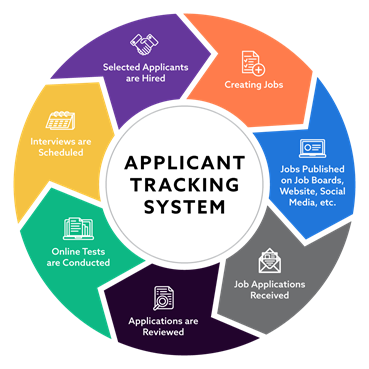Application or Applicant tracking systems are used by players on both sides of the coin i.e. applicants and hiring teams to track, filter and engage with applications throughout the recruitment journey. Today, for corporations which have large scale hiring requirements across profiles and functions, ATS is an indispensable part of the workflow. In fact, at least two thirds of large organizations and close to 98% of Fortune 500 companies use it.
AI-driven applicant tracking system
In recent times, AI has become ubiquitous in software across industries. When it comes to Applicant tracking systems, AI solves some key use cases which saves time, eliminates repetitive manual tasks and makes the end to end process more efficient.
Conversational AI in the form of chatbots can be deployed to engage with candidates. AI powered application tracking systems can automate resume screening based on relevant criteria. They can also rank candidates in order of their eligibility for the role. In the future, we can expect systems to provide detailed portraits of candidates based on limited information available. Such features enable recruiting teams to operate with more agility as well as providing enriched user experiences for candidates.
Web-based Applicant Tracking System
The advantage of using an online application tracking system is that it can be accessed from anywhere with a stable internet connection. Installation of the ATS software on physical systems is not required, eliminating the need for on ground maintenance and management. Essentially this a cloud based system with a third party ATS vendor handling everything remotely, including feature updates and rollouts. This also falls under the category of Software as a Service (SaaS). Users can log in to the service anytime, just like signing in to your email or favorite social networking site. Some are even packaged as browser extensions, which automate laborious workflows. An example – If a user views an applicant resume on a job portal, it will automatically be saved onto a cloud database containing all resumes.
Customized ATS
Off the shelf systems may not work as desired sometimes. The best applicant tracking systems can be customized according to the unique needs and priorities of an organization. Ideally, the system should be designed in such a way that it is in sync with internal workflow. That means the candidate’s information in the ATS should move in the same order as the recruitment sequence which may consist of shortlisting, multiple rounds of interviews etc. Another area where generally a need for customization is apparent is the UI/UX front. A good user experience can sometimes make the difference between landing that rockstar employee and a potential one slipping through the cracks.
Recruitment and Staffing Software
Recruitment software come equipped with tools to streamline the entire staffing process. Such a solution enables teams to post job openings across platforms, keep track of applications received, filter candidates, communicate with applicants and schedule interviews and tests. Staffing software can also be used to deliver targeted messaging in the job market in order to attract interest in a company. According to research by Capterra, 94% of professionals involved in hiring say their recruiting software has positively impacted their process.

Get Started with ATS
Finding the right software
The task of choosing the right ATS solution can seem daunting, with so many different types of options available in the market. It is important to prioritize what you’re looking for, the major issues you’re looking to fix in your process with the ultimate goal of gaining maximum return on your investment. For example – If a company is falling short in the communication and branding aspect of their recruitment strategy, they should look for a solution with a key focus on enriching engagement.
Integrating an ATS into your business process
It is important to understand and be prepared for the kind of organizational changes that arise from adopting a new technology. Buy-in across all levels can help make this make a frictionless transition. While some ATS software are plug and play solutions, making integration faster, more complex and customized solutions require a longer gestation period to fully merge with a company’s workflow. The agility of IT teams and infrastructure is crucial in making this happen
Streamlining your recruitment strategy
Talent is arguably the most important factor determining business success for any organization, be it a small business or a multinational company. The best ATS solutions help streamline recruitment strategies for companies, ensuring hiring and retention of top talent.
1. ATS systems can help translate human resource requirements from different teams into clear job profiles which can stand out in a competitive talent market.
2. They can leverage various job portals and social media channels for professionals like AngelList and LinkedIn to target job seekers who best fit requirements.
3. They can automate various mechanical and time consuming legacy processes across the hiring funnel. This can prevent bottlenecks from occurring, qualified candidates from slipping through the cracks and improve Cost of Acquisition of an employee.
To sum up, a good ATS system can be a highly effective tool in your recruitment arsenal. So prioritize effectively and choose wisely.



